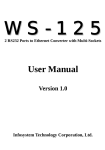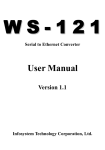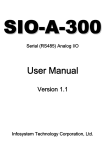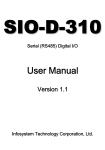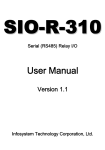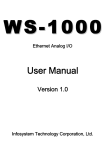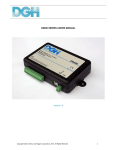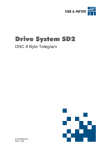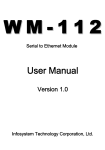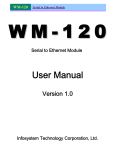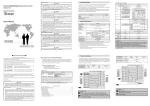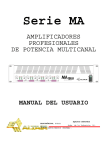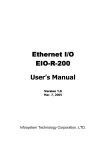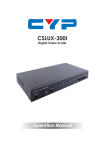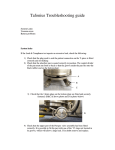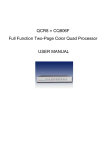Download User Manual - Infosystem Technology Corporation, Ltd.
Transcript
EIO-A-200 Ethernet Analog I/O User Manual Version 1.1 Infosystem Technology Corporation, Ltd. EIO-A-200 Ethernet Analog I/O Controller Infosystem® (Preliminary Version) Index 1. Disclaimers .......................... 1. A. Warranty ......................... 2. B. Trademark ........................ 2. 2. Product Information ....................... 3. A. Introduction ........................ 3. B. Features ......................... 4. C. Applications ....................... 5. 3. Exterior ........................... 6. A. Overview ......................... 6. B. Front Panel ........................ 7. C. Dimension ........................ 7. 4. Specifications ......................... 8. A. Basic Specifications ..................... 8. - Part 1 ....................... 8. - Part 2 ....................... 9. B. LED Indicator and Switch Description .............. 10. - Top View ..................... 10. - Description ..................... 11. C. Wiring .......................... 12. - Analog Input Channels ................. 12. - DC 0.5A Digital Output x 2 (DO1, DO2) ........... 13. D. ModBus Holding Register Definition .............. 14. 5. Software Installation ....................... 23. A. Install ......................... 23. - Step 1: Insert the CD and click the button ........... 23. - Step 2: Click the Link of the Page ............. 24. - Step 3: Press Next to Continue .............. 25. - Step 4: Decide the Application Directory ........... 26. - Step 5: Create the Directory if not existent .......... 27. - Step 6: Create Program’s Shortcut ............. 28. EIO-A-200 Infosystem® Ethernet Analog I/O Controller (Preliminary Version) - Step 7: Decide if Desktop icon needed ............ - Step 8: Press Install to start installation ........... - Step 9: Process Installations ............... - Step 10: Finish Installation ............... B. Uninstall ......................... - Step 1: Execute Uninstall Program ............. - Step 2: Click “Yes” to process ............... - Step 3: Finished .................... 6. Configuration.......................... A. By Browser ........................ - Step 1: Ready to login ................. - Step 2: Configure your parameters ............. - Step 3: Finish and reboot ................ B. By Setup Tools ...................... - Step 1: Searching the devices ............... - Step 2: Double click the selected item ............ - Step 3: Configure and update your parameters ......... C. By Direct Broadcast Commands ................ - Command List A .................... - Command List B ................... - Command List C ................... 7. Application Notes ........................ A. Description ....................... B. Disable Firewall of Windows XP SP2 .............. - Step 1: Execute "Windows Firewall" ............. - Step 2: Close the Firewall ................ C. Make Program exception for Firewall ............... - Step 1: Choose "Exception" ............... - Step 2: Add on New Program ............... - Step 3: Allow "Accept Any Computer" ............ - Step 3: Finished.................... 29. 30. 31. 32. 33. 33. 34. 34. 35. 35. 35. 36. 37. 38. 38. 38. 39. 40. 40. 41. 42. 43. 43. 43. 43. 44. 45. 45. 46. 47. 48. EIO-A-200 Ethernet Analog I/O Controller Infosystem® (Preliminary Version) Disclaimers The information in this manual has been carefully checked and is believed to be accurate. Infosystem Technology Corporation, Ltd. assumes no responsibility for any infringements of patents or other rights of third parties, which may result from its use. Infosystem assumes no responsibility for any inaccuracies that may be contained in this document. Infosystem makes no commitment to update or to keep current the information contained in this manual. Infosystem reserves the right to make improvements to this document and/or product at any time without notice. No part of this publication may be reproduced, stored in a retrieval system, or transmitted in any form of or by any means, electronic, mechanical, photocopying, recording, or otherwise, without the prior written permission of Infosystem Technology Corporation, Ltd. Copyright © 2006 Infosystem Technology Corporation, Ltd. All rights reserved. Printed in Taiwan. 1. EIO-A-200 Ethernet Analog I/O Controller Infosystem® (Preliminary Version) Warranty All products manufactured by Infosystem are warranted against defective materials for a period of one year from the date of delivery to the original purchaser. Trademark The names used for identification only maybe registered trademark of their respective companies. 2. EIO-A-200 Ethernet Analog I/O Controller Infosystem® (Preliminary Version) Product Information A. Introduction EIO is an I/O controller product with Ethernet Port on its data communication and makes data acquisition easier through ModBus/TCP Protocol on Ethernet network. For different conditions, EIO basically has been designed into four models. EIO-R is Relay I/O Controller. EIO-A is Analog I/O Controller. EIO-D is Digital I/O Controller. And EIO-T is Thermocouple I/O Controller. By using these products, the controlling and monitoring of distributed control system can easily be accomplished. EIO-A-200 uses 8051’s family microprocessor for implementing Ethernet functions. It uses the state machine to handle TCP/IP stack with most but limited functions because of the limited resources. EIO-A-200 supports ARP, ICMP, TCP, UDP, IP, DHCP-Client and even HTTP protocols. You can use any browsers to set the parameters, or just use the commands in console mode. With no doubt, EIO-A-200 will bring you the best integration in your applications. 3. EIO-A-200 Ethernet Analog I/O Controller Infosystem® (Preliminary Version) Product Information B. Features ¾ Easy Configuration Setting 9 Use Setup Tools to Configure the Settings 9 Use HTTP, IE/Netscape Browser for Setting ¾ Good Security Concerned 9 Setup Login in Password Protect 9 Access Password Protect ¾ High Reliability 9 Stable and Robust 9 Working 24Hours per day ¾ Support Necessary Network Protocols 9 ARP, ICMP, TCP, UDP, IP, DHCP Client, HTTP ¾ Support ModBus Protocol 9 ModBus/TCP, ModBus/RTU, ModBus/ASCII 9 Easy integration with HMI/SCADA or OPC Server ¾ Multi-Channel and High Resolution 9 8 single-ended input channel with 16-bit resolution ¾ Support Four Operation Module 9 9 9 9 Voltage Inputs: 0~10V Voltage Inputs: 1-5V Current Inputs: 0~20mA Current Inputs: 4~20mA ¾ Built-in high/low limitation detection capabilities 9 Users Engineering Limitations could be manually adjusted. 4. EIO-A-200 Ethernet Analog I/O Controller Infosystem® (Preliminary Version) Product Information C. Applications ¾ ¾ ¾ ¾ ¾ ¾ ¾ ¾ ¾ ¾ ¾ ¾ ¾ ¾ ¾ ¾ Data collection and Security Terminals Access Control Terminals Security Devices Time Recorders Warehouse Terminals Shop floor automation Terminals Remote Sensors and Meters Power monitors Power meters Environmental monitors Temperature monitors Data loggers Auto-ID Scanners Barcode Scanners Magnetic Card Readers Basic Input/Output Operation 5. EIO-A-200 Ethernet Analog I/O Controller Infosystem® (Preliminary Version) Exterior A. Overview RJ-45 Ethernet Port Analog Input LED Indicator Discrete Output LED DC 24V Power Input Dip Switch Analog Input 6. Discrete Output EIO-A-200 Ethernet Analog I/O Controller Infosystem® (Preliminary Version) Exterior B. Front Panel a. Connector 1 (CONN1) b. 10 BASE-T Ethernet c. Discrete Output LED Indication d. LED Indicator e. Connector 2 (CONN2) C. Dimension 94.0 80.0 33.0 50.0 102.0 4 xψ3.0 9.0 7. (UNIT: mm) Ethernet Analog I/O Controller EIO-A-200 Infosystem® (Preliminary Version) Specifications A. Basic Specifications – Part 1 – Entry Network Interface Protocol Number of channels Input ranges Description 10BaseT, RJ-45 ARP, ICMP, TCP, UDP, IP, DHCP Client, HTTP, Modbus/TCP 8 (differential input) 0-10V, 1-5V (input impedance 10MΩ) 0-20mA, 4~20mA (input impedance 250Ω) Resolution 16 bit Inaccuracy ±0.2% max at 25℃ Zero drift +/-0.06 μV/℃ Span drift +/-30 PPM/℃ Conversion speed 800 ms/8 channel Channel isolation Non-isolated (one common) Power consumption Range selection 0.2A Dip switches Number of output points 2 points Insulation method Photo coupler Rated load voltage 24VDC Type NPN/Sink 8. EIO-A-200 Ethernet Analog I/O Controller Infosystem® (Preliminary Version) Specifications A. Basic Specifications – Part 2 – Entry Description Max. load current 0.5A/pt Leakage current at OFF circuit 0.1mA or less Max. voltage drop at ON circuit 1.5V or less Response time OFF Æ ON 8 msec or less ON Æ OFF 8 msec or less Voltage 2 points/common 24VDC (21.6VDC~26.4VDC) Current 100mA Common terminal arrangement External power supply International current consumption 50 mA (type, all points on) Operating temperature 0 ~60℃ Storage temperature -20 ~ 80℃ Relative humidity 15 ~ 95 % RH (non-condensing) Environment air Voltage No corrosive gases permitted 24Vdc (7Vdc~36Vdc) Current 80mA External power supply International current consumption 9. 50 mA (type, all points on) Ethernet Analog I/O Controller EIO-A-200 Infosystem® (Preliminary Version) Specifications B. LED Indicator and Switch Description – Top View – 9 CONN1 1 Ethernet DO1 DO2 SYS TOP View RX TX LINK SW 1 CONN2 12 10. 13 Ethernet Analog I/O Controller EIO-A-200 Infosystem® (Preliminary Version) Specifications B. LED Indicator and Switch Description – Description – LED Indicator: LED Description SYS The SYS LED blinks at a rate of 1.5Hz and indicating normal work. RX Received data. TX Transmitted data. LINK DO1~DO2 If ON, the Ethernet connection is activated. The DC outputs1~2. Switch Description: Defining Operation Range Users may set the positions of the dip switches which are located on the bottom side of the module to choose one of the operation ranges provided by the EIO-A-200 module. SW1 SW2 EIO-A-200 OPERATION RANGE ON OFF Voltage inputs: 0~10V ON ON Voltage inputs: 1~5V OFF OFF Current inputs: 0~20mA OFF ON Current inputs: 4~20mA 11. Ethernet Analog I/O Controller EIO-A-200 Infosystem® (Preliminary Version) Specifications C. Wiring Users may refer to the following diagram to connect the external wiring for the EIO-A-200 module. (Wires for analog input signals are recommended to have the shielding protection) – Analog Input Channels– CH1+ 1 9 CONN1 1 CH1- Ethernet CH2+ CH2- CONN1 CH3+ CH3- DO1 CH4+ DO2 CH4AGND 9 CH5+ 1 SYS EIO-A-200 RX TX LINK CH5CH6+ CH6CH7+ CONN2 CH7CH8+ CH8- 8 ~~ ~~ 13 SW 1 12 12. CONN2 13 EIO-A-200 Ethernet Analog I/O Controller Infosystem® (Preliminary Version) Specifications C. Wiring – DC 0.5A Digital Output x 2 (DO1, DO2) – 13. EIO-A-200 Ethernet Analog I/O Controller Infosystem® (Preliminary Version) Specifications D. ModBus Holding Register Definition The EIO-A-200 module provides 11 registers (words) for users to access the status of the module and read the data from the input channels or write the data to the output register. These 11 registers are called scan data registers. The definitions of the 11 registers are described as follows: EIO-A-200 Scan Data Address (ModBus Holding Register Address) Description 40001 Digital Output Register 40003 Line Broken Detection Flags 40004 Status Register 40005 Channel 1 Input Register 40006 Channel 2 Input Register 40007 Channel 3 Input Register 40008 Channel 4 Input Register 40009 Channel 5 Input Register 40010 Channel 6 Input Register 40011 Channel 7 Input Register 40012 Channel 8 Input Register 14. EIO-A-200 Ethernet Analog I/O Controller Infosystem® (Preliminary Version) Specifications D. ModBus Holding Register Definition Digital output register: (40001) Bit 1: DO1 output status Bit 2: DO2 output status Bit 3 to Bit 16 are reserved. Line broken detection flags: (40003) Bit1 ~ Bit8 are corresponding to the channel 1 ~ channel 8 Bit status = 1 (line broken) = 0 (normal) Status (flag) register: (40004) Bit 1: low limitation flag of channel 1 Bit 2: high limitation flag of channel 1 Bit 3: low limitation flag of channel 2 Bit 4: high limitation flag of channel 2 Bit 5: low limitation flag of channel 3 Bit 6: high limitation flag of channel 3. Bit 7: low limitation flag of channel 4 Bit 8: high limitation flag of channel 4 Bit 9: low limitation flag of channel 5 Bit 10: high limitation flag of channel 5 Bit 11: low limitation flag of channel 6 Bit 12: high limitation flag of channel 6 Bit 13: low limitation flag of channel 7 Bit 14: high limitation flag of channel 7 Bit 15: low limitation flag of channel 8 Bit 16: high limitation flag of channel 8 15. EIO-A-200 Ethernet Analog I/O Controller Infosystem® (Preliminary Version) Specifications D. ModBus Holding Register Definition Besides the scan data registers, the EIO-A-200 module also provides other Modbus holding registers for users to fill in the high/low limit value and define the conversion data type. High- and low-limit values will be used by the module for comparing the channel’s input signal to detect if the input signal is higher or lower than the limitation value set by the user. If the value of an input channel is higher or lower than the corresponding data stored in these holding registers, the corresponding flag bit of the status register in the scan data registers will be set to ‘1’. The conversion data for each channel may be represented by the raw conversion data defined by the module or engineering data defined by users. If users define the conversion data type to be an engineering data, users may set the low engineering value and the high engineering value using the specified holding registers from 40033~40048 for each of the input channel instead of the raw data range defined by the module. The corresponding input signals will be linearly converted to the engineering data corresponding to the defined range of high/low engineering setting value to the corresponding channel input registers in scan data registers. Users will be requested to use the engineering data to define the high/low limitation values for the corresponding channels if users select the conversion data type with engineering data. 16. EIO-A-200 Ethernet Analog I/O Controller Infosystem® (Preliminary Version) Specifications D. ModBus Holding Register Definition Holding Register Description 40013 Flags for control A/D conversion 40014 High/low limit control flags 40015 Low limitation value of CH1 40016 High limitation value of CH1 40017 Low limitation value of CH2 40018 High limitation value of CH2 40019 Low limitation value of CH3 40020 High limitation value of CH3 40021 Low limitation value of CH4 40022 High limitation value of CH4 40023 Low limitation value of CH5 40024 High limitation value of CH5 40025 Low limitation value of CH6 40026 High limitation value of CH6 40027 Low limitation value of CH7 40028 High limitation value of CH7 40029 Low limitation value of CH8 40030 High limitation value of CH8 40031 Reserved 17. EIO-A-200 Ethernet Analog I/O Controller Infosystem® (Preliminary Version) Specifications D. ModBus Holding Register Definition Holding Register Description 40032 Conversion data type (row data or engineering data) 40033 Low engineering setting value of CH1 40034 High engineering setting value of CH1 40035 Low engineering setting value of CH2 40036 High engineering setting value of CH2 40037 Low engineering setting value of CH3 40038 High engineering setting value of CH3 40039 Low engineering setting value of CH4 40040 High engineering setting value of CH4 40041 Low engineering setting value of CH5 40042 High engineering setting value of CH5 40043 Low engineering setting value of CH6 40044 High engineering setting value of CH6 40045 Low engineering setting value of CH7 40046 High engineering setting value of CH7 40047 Low engineering setting value of CH8 40048 High engineering setting value of CH8 18. EIO-A-200 Ethernet Analog I/O Controller Infosystem® (Preliminary Version) Specifications D. ModBus Holding Register Definition Conversion control/speed flags: (40013) 1. Bit 1 to Bit 8 are reserved. 2. Bit 9 to Bit 16 are A/D conversion control flags. ‘0’: enable A/D conversion (default) ‘1’: disable A/D conversion 19. EIO-A-200 Ethernet Analog I/O Controller Infosystem® (Preliminary Version) Specifications D. ModBus Holding Register Definition High/low limit control flags: (40014) Bit 1: low limitation control bit for CH1 Bit 2: high limitation control bit for CH1 Bit 3: low limitation control bit for CH2 Bit 4: high limitation control bit for CH2 Bit 5: low limitation control bit for CH3 Bit 6: high limitation control bit for CH3 Bit 7: low limitation control bit for CH4 Bit 8: high limitation control bit for CH4 Bit 9: low limitation control bit for CH5 Bit 10: high limitation control bit for CH5 Bit 11: low limitation control bit for CH6 Bit 12: high limitation control bit for CH6 Bit 13: low limitation control bit for CH7 Bit 14: high limitation control bit for CH7 Bit 15: low limitation control bit for CH8 Bit 16: high limitation control bit for CH8 20. EIO-A-200 Ethernet Analog I/O Controller Infosystem® (Preliminary Version) Specifications D. ModBus Holding Register Definition Remarks: 1. If some bits of the high/low limit control flags are set to ‘1’, the input Signals of corresponding channels will be compared with the corresponding limitation values which were stored in the specified holding registers. If the corresponding channel’s input value is higher or lower than the corresponding limitation value stored in the specified holding register, the corresponding flag bit of the status register (40004) will be set to ‘1’. 2. Users do not need to set the control bit or initiate the data to the specified holding registers if high/low limit detection is not required in the application. Conversion data type: (40032) Bit 1: CH1’s conversion data type Bit 2: CH2’s conversion data type Bit 3: CH3’s conversion data type Bit 4: CH4’s conversion data type Bit 5: CH5’s conversion data type Bit 6: CH6’s conversion data type Bit 7: CH7’s conversion data type Bit 8: CH8’s conversion data type 21. EIO-A-200 Ethernet Analog I/O Controller Infosystem® (Preliminary Version) Specifications D. ModBus Holding Register Definition Remark: 1. The default status of the above bits is ‘0’. In other words, the default conversion data type for each channel is raw data. 2. If some bits of the data conversion bits are set to ‘1’, the input signals of corresponding channels will be converted to the corresponding engineering data and stored to the channel input registers in scan data registers. High/low engineering setting values: (40033~40048) 1. Users may fill in the low engineering values and high engineering values to the corresponding holding registers from 40033 to 40048 for each of the channel instead of the raw data range defined by the module. Users may check the raw data conversion table in the following chapter. 2. If users set the module’s conversion data type to be an engineering data, the module will use to the range of the high/low engineering setting values defined by the users and linearly convert the input signal to the corresponding engineering data to the corresponding channel input register in the scan data register. 22. EIO-A-200 Ethernet Analog I/O Controller Infosystem® (Preliminary Version) Software Installation A. Installation Step 1: Insert the CD and click the button The Software Installation CD that came with EIO-A-200 will automatically be run after inserting it into the CD-ROM drive. Click the “Ethernet converter Setup Utilities” button will bring the installation page out, Figure1. Software Install CD Auto-Run Screen Shot 23. EIO-A-200 Ethernet Analog I/O Controller Infosystem® (Preliminary Version) Software Installation A. Installation Step 2: Click the Link of the Page Click the Link of the Page to run the Ethernet Converter Setup Tools Installation Software. Figure2. Ethernet Converter Setup Tools Page 24. EIO-A-200 Ethernet Analog I/O Controller Infosystem® (Preliminary Version) Software Installation A. Installation Step 3: Press Next to Continue Figure3. Installation Welcome Message 25. Ethernet Analog I/O Controller EIO-A-200 Infosystem® (Preliminary Version) Software Installation A. Installation Step 4: Decide the Application Directory Figure4. Decide the Application Directory 26. EIO-A-200 Ethernet Analog I/O Controller Infosystem® (Preliminary Version) Software Installation A. Installation Step 5: Create the Directory if not existent Figure5. Create Application Directory 27. EIO-A-200 Ethernet Analog I/O Controller Infosystem® (Preliminary Version) Software Installation A. Installation Step 6: Create Program’s Shortcut Figure6. Shortcut Creation 28. EIO-A-200 Ethernet Analog I/O Controller Infosystem® (Preliminary Version) Software Installation A. Installation Step 7: Decide if Desktop icon needed Figure7. Desktop Icon Creation 29. EIO-A-200 Ethernet Analog I/O Controller Infosystem® (Preliminary Version) Software Installation A. Installation Step 8: Press Install to start installation Figure8. Review the Installation Settings 30. EIO-A-200 Ethernet Analog I/O Controller Infosystem® (Preliminary Version) Software Installation A. Installation Step 9: Process Installations Figure9. Installing 31. EIO-A-200 Ethernet Analog I/O Controller Infosystem® (Preliminary Version) Software Installation A. Installation Step 10: Finish Installation Figure10. Installation Finished 32. Ethernet Analog I/O Controller EIO-A-200 Infosystem® (Preliminary Version) Software Installation B. Uninstall Step 1: Execute Uninstall Program Uninstall Program is located at the application directory named “Uninstall Ethernet Converter Setup”. Execution of it could let the Ethernet Converter Setup Tools clearly be removed. Figure11. Decide the Application Directory 33. EIO-A-200 Ethernet Analog I/O Controller Infosystem® (Preliminary Version) Software Installation B. Uninstall Step 2: Click “Yes” to process Figure12. Process Uninstall Step 3: Finished Figure12. Process Uninstall 34. EIO-A-200 Ethernet Analog I/O Controller Infosystem® (Preliminary Version) Configuration A.By Browser Step 1: Ready to login. 35. EIO-A-200 Ethernet Analog I/O Controller Infosystem® (Preliminary Version) Configuration A. By Browser Step 2: Configure your parameters. 36. EIO-A-200 Ethernet Analog I/O Controller Infosystem® (Preliminary Version) Configuration A. By Browser Step 3: Finish and reboot. 37. EIO-A-200 Ethernet Analog I/O Controller Infosystem® (Preliminary Version) Configuration B. By Setup Tools Step 1: Searching the devices. Step 2: Double click the selected item. 38. EIO-A-200 Ethernet Analog I/O Controller Infosystem® (Preliminary Version) Configuration B. By Setup Tools Step 3: Configure and update your parameters. 39. EIO-A-200 Ethernet Analog I/O Controller Infosystem® (Preliminary Version) Configuration C. By Direct Broadcast Commands It needs broadcasting to handle all the configurations and it allows users to code their own application software. – Command List A – User Level – – Command X or x Description Notes Purpose Syntax Magic code Return For Broadcast search Example G or g Purpose Syntax Return X <magic code> 99.130.83.99 AX <MAC>/<IP>/<Device ID> Send X 99.130.83.99 Back AX 0.128.200.255.251.242/192.168.1.1/1 Get all the parameters of the WM-110 G <MAC>/<IP>/<Setup Password> All the parameters of the WM-110 Send Example Back G 0.128.200.255.251.242/192.168.1.1/123 CG for cancel AG<All Messages> 40. EIO-A-200 Ethernet Analog I/O Controller Infosystem® (Preliminary Version) Configuration C. By Direct Broadcast Commands User Level: Admin Level: For General Users For Factory Default Setting – Command List B – User Level – Command Description Notes Purpose Syntax S Return Example Purpose Syntax R Return Example Set the parameters of WM-110 S <MAC>/<IP>/<Password>/<Parameter>/<Value> A for accept C for cancel Send S 0.128.200.255.251.242/192.168.1.1/123/IP/192.168.1.2 Back A or C Reboot WM-110 R <MAC>/<IP>/<Setup Password> AR for accept CR for cancel Send R 0.128.200.255.251.242/192.168.1.1/123 Back AR or CR 41. EIO-A-200 Ethernet Analog I/O Controller Infosystem® (Preliminary Version) Configuration C. By Direct Broadcast Commands User Level: Admin Level: For General Users For Factory Default Setting – Command List C – Admin Level – Command Description Notes Purpose Syntax M Return Example Purpose Syntax I Return Example Set MAC address of WM-110 then reboot automatically M <Old MAC>/<New MAC>/<Factory Password> AM for accept CM for cancel Send S 0.128.200.255.251.242/0.128.200.255.251.243/123 Back ‘A’ or ‘C’ Set IP for Factory settings I <MAC>/<New IP>/<Factory Password> AI for accept CI for cancel Send I 0.128.200.255.251.242/192.168.1.1/123’ Back AR or CR 42. EIO-A-200 Ethernet Analog I/O Controller Infosystem® (Preliminary Version) Application Notes A. Description: Firewall will make the program off normal, so one might choose the following solutions to Firewall program, “Disable” or “Exception”. B. Disable Firewall of Windows XP SP2. Step 1: Execute "Windows Firewall" Execute “Windows Firewall” in Control Panel. 43. EIO-A-200 Ethernet Analog I/O Controller Infosystem® (Preliminary Version) Application Notes B. Disable Firewall of Windows XP SP2. Step 2: Close the Firewall Choose “Close” to close firewall. 44. EIO-A-200 Ethernet Analog I/O Controller Infosystem® (Preliminary Version) Application Notes C. Make Program exception for Firewall Step 1: Choose "Exception" Choose “Exception” in Firewall Program. And add on new program of Setup Tools. 45. EIO-A-200 Ethernet Analog I/O Controller Infosystem® (Preliminary Version) Application Notes C. Make Program exception for Firewall Step 2: Add on New Program and Selection Choose “Setup Tools” to make it as an exception. 46. EIO-A-200 Ethernet Analog I/O Controller Infosystem® (Preliminary Version) Application Notes C. Make Program exception for Firewall Step 3: Allow "Accept Any Computer" Allow “Accept Any Computer” to finish exception. 47. EIO-A-200 Ethernet Analog I/O Controller Infosystem® (Preliminary Version) Application Notes C. Make Program exception for Firewall Step 4: Finished Finish Exception. 48. Infosystem® Copyright © 2006 Infosystem Technology Corporation, Ltd. No. 45, Lane 167, Dongnan St. Hsinchu, Taiwan 300, R.O.C. TEL: +886-3-562-7187 FAX: +886-3-561-1435 Service E-mail: [email protected] Web page URL:http://www.infosystem.com.tw




















































